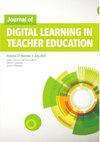Publishing trends in JDLTE: A five-year perspective
Q1 Social Sciences
Journal of Digital Learning in Teacher Education
Pub Date : 2022-07-03
DOI:10.1080/21532974.2022.2107321
引用次数: 0
Abstract
We thought it would be interesting to examine the last five volumes (33; 2017 − 37; 2021) of the Journal of Digital Learning in Teacher Education (JDLTE) to identify topics and trends that have emerged around publishing in this dynamic area. In the last five volumes we published 82 articles, compiled two special issues (Makerspaces in Teacher Education, 2018 and Computational Thinking in Teacher Education, 2020), and recorded 59,884 article views to date. Submissions have steadily increased these past five years, as interest around publishing about digital learning in teacher education continues to grow. Figure 1 represents a breakdown of the topics covered by research articles published in these last five volumes. We used very broad categories to classify and illustrate the distribution of topics in these issues. For example, one-third of the articles published involved pre-service (22%) and in-service teachers (11%) as participants. Several articles (17%) published during this time, a pivotal time in distance education, focused on online learning or online professional development. Technology specific topics like computational thinking/coding (12%), TPACK (8%), and makerspaces (5%) were also present. Articles with a technology/content area focus (11%), such as literacy, mathematics, or STEM, remain an important focus for JDLTE. The remaining articles (14%) covered various topics across technology and teacher education – like validating questionnaires, promoting school-university partnerships, and using technology for reflection. These five volumes also included JDLTE Outstanding Research Paper Awards that are presented annually at the ISTE conference. One article is selected from each volume that has a high probability to advance the field of technology and teacher education. It is worth listing the last five paper award winners here, noting the important and timely topics covered in these articles:JDLTE的出版趋势:五年展望
我们认为检查最后五卷(33;2017−37;《教师教育中的数字学习杂志》(JDLTE),以确定围绕这一动态领域的出版出现的主题和趋势。在过去的五卷中,我们发表了82篇文章,编写了两期特刊(教师教育中的创客空间,2018年和教师教育中的计算思维,2020年),迄今已有59,884篇文章的阅读量。在过去的五年里,随着人们对教师教育中数字学习的兴趣持续增长,提交的作品稳步增加。图1表示了最近五卷中发表的研究文章所涵盖的主题的细分。我们使用非常广泛的类别来分类和说明这些问题中的主题分布。例如,发表的文章中有三分之一的参与者是职前教师(22%)和在职教师(11%)。这段时间是远程教育的关键时期,有几篇文章(17%)发表在网上学习或网上职业发展方面。技术特定主题,如计算思维/编码(12%),TPACK(8%)和创客空间(5%)也出现了。侧重于技术/内容领域的文章(11%),如识字、数学或STEM,仍然是JDLTE的重要关注点。其余的文章(14%)涵盖了技术和教师教育的各种主题,比如验证问卷,促进学校和大学的合作关系,以及利用技术进行反思。这五卷还包括JDLTE杰出研究论文奖,该奖项每年在ISTE会议上颁发。每一卷中选出一篇有可能推动技术和教师教育领域发展的文章。这里有必要列出最近的五篇获奖论文,并指出这些文章中涉及的重要和及时的主题:
本文章由计算机程序翻译,如有差异,请以英文原文为准。
求助全文
约1分钟内获得全文
求助全文
来源期刊

Journal of Digital Learning in Teacher Education
Social Sciences-Education
CiteScore
4.90
自引率
0.00%
发文量
15
 求助内容:
求助内容: 应助结果提醒方式:
应助结果提醒方式:


